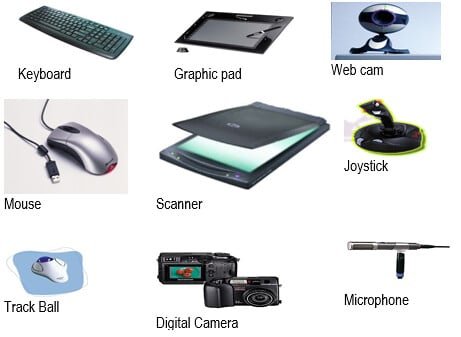4a Hardware and Software
Hardware
CPU, disks, mouse, printer, etc.
System software
Operating system
Utilities
Application software
Computer games
Spreadsheets
Word processors
Databases
Internet browsers
Hardware & Software
System software
The operating system and all utility programs that manage the computer resources at a low level.
They are designed to run a computer's hardware and application software.
The system software is the interface between the hardware and user applications.
Application software
Software that allows a computer to perform useful tasks beyond the running of the computer itself.
A collection of physical 'things' that, when put together in a certain way, form a system.
Hardware
CPU
Memory
Storage devices
Input devices
Output devices
Communication devices




Processing devices and main memory
Main memory
CPU
GPU
Input devices
Keyboard
Mouse
Scanner
Camera
Microphone
Output devices
Printer
Monitor
Speakers
Tactile devices
Braille displays
Communication devices
Modem
Network card
Bluetooth
Storage devices
Hard drives
Flash drives
Optical drives
Input Devices
Any device that allows a human to get information to the computer.
Input Devices
Name six input devices
- Keyboard
- Mouse
- Microphone
- Camera
- Joystick/Game Pad
- Touch screen
User Interface
UI - the means by which a user can control a software application or a hardware device.
Graphical User Interface
GUI - a user interface that uses graphical controls, accessed via a mouse, touchpad, touchscreen or keyboard.
Output Devices
Any device that allows a computer to get information to the human.
Output Devices
Name six output devices
- Screen
- Speaker
- Printer
- GPS
- Haptic feedback (vibration)
- Braille device
Communication Devices
Any device that allows the transfer of data between two or more other devices.
Communication Devices
Name four communication devices
- Modem
- WiFi card
- Network card
- Bluetooth
Operating System

Operating System Tasks
Recognises and installs peripheral devices

Manages files and folders
Shares out system memory
Handles system errors and alerts user
Manages system security
Allows software to communicate with hardware
Moves data to and from the hard disk
Loads and runs other software applications
Handles inputs and outputs
Handling and managing all of the system resources
The operating system handles the computer's memory and the sharing of the central processing unit (CPU). Makes sure each application gets the correct and adequate resources.
Key functions:
- memory management
- processor management
- I/O management
- file management
- security
- error handling
- program management
- interaction with the user.
Memory Management
- Controlling the allocation of memory and dealing with the transfer of programs in and out of memory when the process no longer needs it when the process has been ended.
Processor Management
- Carrying out a process called scheduling where it manages the CPU.
- Organising processing time between programs and users.
- Keeping track of processors and the status of any process running.
I/O Management
- Manages all the input and output devices, including controlling the backing store and all peripherals. This is done with device drivers.
- Translates instructions sent by application software into a format that I/O devices can understand.
- Decides which process gets the device, when and for how much time.
Specially written program which translates the commands from an operating system into commands that the hardware will understand.
File Management
- Allows the user to perform tasks including the creation of files and directories.
- Allows the user to save files to a backing store.
- Allows the user to rename, copy, move and delete files.
- Keeps track of where files are located on the hard drive.
FAT - file allocation table
NTFS - new technology file system
ext4, btfs, xfs - other file systems
Security
- Controls access to programs, processes and users to the computer resources.
- Ensures that all access to system resources is controlled.
- Ensures that external I/O devises are protected from invalid access attempts.
- Provides an authentication feature for each user by means of a password.
Error Handling
- Monitors the system for any errors that occur.
- Takes appropriate actions to ensure correct operations.
- Closes the program if errors are terminal.
Application Management
- Loads a program into memory.
- Allows the application software to communicate with the hardware.
- Provides a mechanism for processing all internal communication.
Utility Software
- Helps manage, maintain and control computer resources.
- Virus scanner
- protects against viruses and Trojans
- Disk defragmenter
- speeds up the hard disk
- System monitor
- watches the current system resources
Application Software
Allows the computer to perform useful tasks.
- Animation software
- Audio editing
- Data manipulation (databases and spreadsheets)
- Graphics software
- Presentation software
- Text editors (word processors, desktop publishing)
- Web browser
Questions
- Which of these is not hardware?
graphics card operating system optical drive internet browser
- True or false? All hardware is found inside the computer.
- Explain the difference between software and hardware.
- Suggest why smartphones would be considered a general purpose system rather than dedicated systems.
Questions
- Which of these is not hardware?
graphics card operating system optical drive internet browser
- True or false? All hardware is found inside the computer.
- Explain the difference between software and hardware.
- Suggest why smartphones would be considered a general purpose system rather than dedicated systems.
Software is the programs and applications that a computer runs.
Hardware is the physical components that make up a computer.
Smartphones are designed to be flexible and re-programmable to perform lots of different tasks.
4a Hardware and Software
Hardware
CPU, disks, mouse, printer, etc.
System software
Operating system
Utilities
Application software
Computer games
Spreadsheets
Word processors
Databases
Internet browsers
4a Hardware and Software
By David James
4a Hardware and Software
Computer Science - Computer Systems - Hardware and Software
- 555



